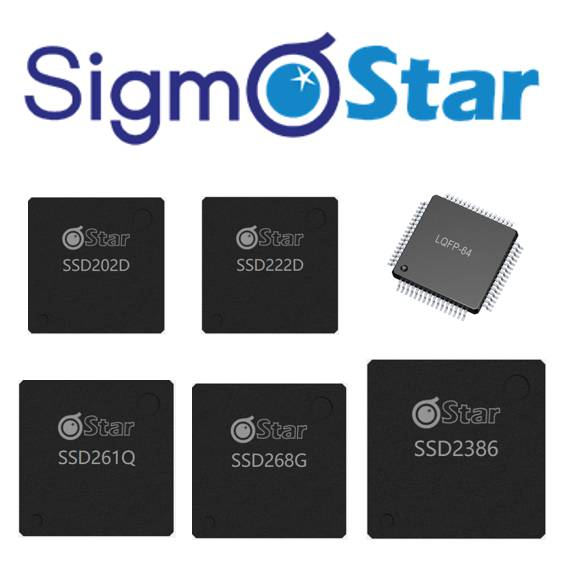I. Video Image Processing
Video is composed of continuous image frames. Due to the persistence of vision of the human eye, when the frame sequence is played at a certain rate, what we perceive is a video with continuous motion. Given the extremely high similarity among consecutive image frames, for the convenience of storage and transmission, we need to use video codecs to encode and compress these sets of images.
Video codecs can compress video data into extremely small files, facilitating online viewing or storage on storage devices. Currently, the commonly - used video codecs are mainly H.264/AVC and H.265/HEVC. Among them, H.264 is the most widely - applied video codec at present. It was the most prevalently used video encoding format during the era of Full HD video (1080p) and is well - known as the encoding and decoding standard for Blu - ray discs.
Under the condition of the same image quality, the compression ratio provided by H.264 is more than twice that of the previous MPEG - 2 and 1.5 - 2 times that of MPEG - 4. It is suitable for online video playback or storage on DVD discs. H.264 is currently in widespread use and has better compatibility with devices and platforms. However, it is unable to meet the application and popularization needs of 4K and 8K ultra - high - definition videos.
H.265 inherits the hybrid video coding framework of H.264. Theoretically, under the same picture quality and bit rate, H.265 requires 50% less storage space than H.264. It features low bit - rate and high - quality technology. The popularization of 4K ultra - high - definition movies depends on the development of H.265 technology.
H.266/VVC is the latest generation of video coding standard finalized in 2020. Its coding performance is 49% better than that of H.265, which can save nearly 50% of transmission traffic. Moreover, it provides better support for new video types such as 8K ultra - high - definition, screen, high - dynamic, and 360 - degree panoramic videos. However, currently, H.266 codecs have not been widely adopted, and it is expected that they will not be widely accepted and used until 2027.
II. SigmaStar Display Series
SigmaStar Technology Co., Ltd. is a leading domestic supplier of AI Camera system-on-chip (SoC) and solutions. It has significant advantages in cutting-edge chip technology fields such as professional security Image Signal Processor (ISP), audio and video encoding and decoding, artificial intelligence processors, audio and video transmission, and display.
The company is committed to providing globally competitive chips and solutions to customers and consumers around the world. Its products are widely used in various fields, including IP Camera, USB Camera, Car Camera, Action Camera, as well as intelligent Network Video Recorder (NVR), smart home systems, and intelligent display devices.
In the markets of IPC digital network cameras and network video recorders, the segmented market of full HD dash cams, the field of USB Camera video conferencing systems, and the intelligent display field, SigmaStar Technology maintains a leading market share.
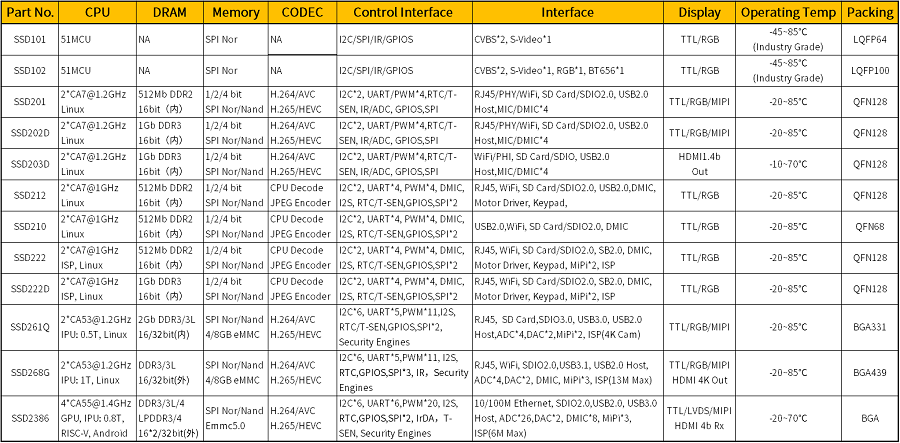
Figure : SSD Display Chip Family
1)SSD10X Series Display Control Chips
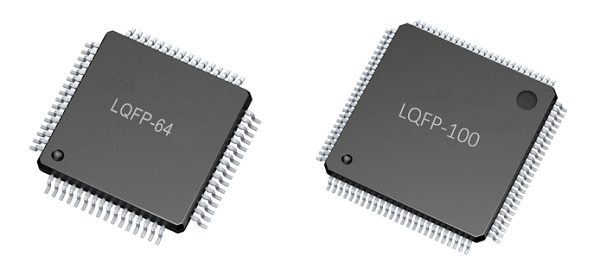

The SSD101 is a low - cost and simple solution introduced by SigmaStar for driving small - sized TTL - RGB interface LCD screens. It supports video format inputs in NTSC, PAL, and SECAM standards and has a TTL output. Generally, it is used to drive digital LCD displays with small - sized TTL RGB interfaces. This chip offers high cost - effectiveness, comes in a QFP64 package, features a small size and low power consumption, and can be powered by a battery. The SD101 is mainly applied in vehicle - mounted display drivers, video doorbells, and some small - sized LCD display products that only require CVBS (AV) input.
The SSD102 is a highly integrated and high - performance Display Controller. It supports analog inputs of NTSC/PAL/SECAM CVBS, S - video, VGA, and YPbPr signals. It can automatically detect video signal sources and modes and smoothly switch between different signal sources. It has a built - in 2D comb filter and AGC, supports 6 - bit/8 - bit TTL/TCON displays, and is packaged in QFP100. Both the SSD101 and SSD102 meet industrial specifications.
2)SSD20X Series
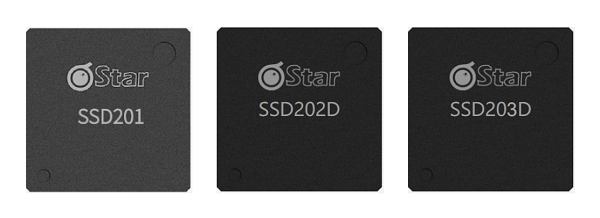

The SSD201/SSD202D/SSD203D are highly integrated embedded SoCs introduced by SigmaStar. Based on a dual - core ARM Cortex - A7 running at 1.2GHz, they integrate H.264/H.265 video encoders, have a built - in 64MB DDR2 or 128MB DDR3, a 2D image engine, Ethernet MAC and PHY, and an audio codec. They support TTL/MIPI screen display driver interfaces with a maximum resolution of 1080P. They also support Secure Boot, an AES/DES/3DES cryptographic engine, and use a secure boot and personalized authentication mechanism to protect the system.
The SSD20X series chips are widely used in scenarios such as indoor intercoms in intelligent buildings, smart home central controls, 86 - box home central controls, elevator floor displays, IP network broadcasting devices, and voice recognition devices. They are an ideal choice for product upgrades to add HMI interaction. Among them, the SSD202D chip is also widely used in the field of electric vehicle meters, especially in the popular round - screen series it has developed.
3)SSD2XX Series


The SSD212 chip supports the embedded Linux system and various GUI development tools. It has a built - in Ethernet MAC and integrated PHY functions. The AES/DES/3DES cryptographic engine can also help encrypt compressed video/audio streams to protect privacy. If the embedded Free RTOS system is used, the full boot process can be completed within 200ms.
The SSD212 has made improvements in audio performance and is very suitable for application scenarios such as smart homes, elevators, industrial control, and IP voice broadcasting. Multiple leading enterprises in the building intercom industry have achieved mass production, and it offers high cost - effectiveness. The SSD212 chip is very suitable for use in 86 - box products and SIP telephones.
The SSD222/222D/222Q use a dual - core ARM Cortex A7 with a main frequency of 1GHz and have a built - in high - performance ISP core. They have a built - in 64MB DDR2/128MB DDR3/256MB DDR3 respectively. They also have a built - in 2D graphics engine and Ethernet driver, support TTL screen display driver interfaces, and integrate a rich set of peripheral interfaces such as SAR ADC, audio ADC/DAC, UART, PWM, GPIO, and SPI. They support the embedded Linux system and various GUI graphic development interface tools such as Flythings, LittleVGL, AWTK, TD - UI, QT, and mini - GUI. They can also support the Free RTOS system and cooperate with the LittleVGL graphic interface to develop products. They are mainly applied in fields such as smart homes, industrial control, portable devices, audio - video and home appliances, and the Internet of Things, including scenarios such as building intercoms, access control systems, face - recognition door locks, and commercial displays.
4)Intelligent Display Chip Series with AI Computing Power
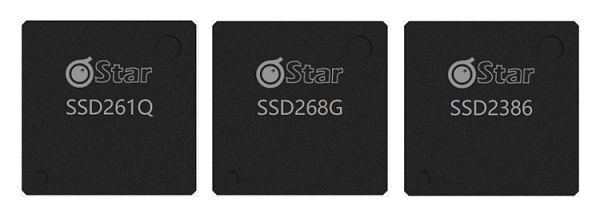

The SSD268G/SSD261Q are highly integrated and multi - functional AI chips introduced by SigmaStar. They use a dual - core ARM Cortex - A53 CPU with a main frequency of 1.2GHz, enabling fast startup, real - time performance, and connection with various peripheral interfaces. They have a built - in professional ISP image processor, support multi - camera inputs, and use MIPI/RGB interfaces to drive high - definition screens. Among them, the SSD268G has an HDMI output and supports dual - screen heterogeneous display. They have a built - in IPU artificial intelligence processor, supporting large - scale AI computing power; a built - in H.264/265 codec, supporting multi - channel encoding and decoding; and a built - in audio codec and Ethernet interface. They are an ideal solution for designing and developing high - performance, high - quality, and low - cost products.
The SSD26X series chips are mainly applied in fields such as live - streaming cameras, video conferencing, industrial cameras, new retail, education, and live - streaming. Specific applications include live - streaming cameras, intelligent homework lamps, self - service karaoke machines, home studio equipment, supermarket self - service cash registers, express delivery and storage cabinets, self - service vending machines, queuing and calling displays, video conferencing webcams, motion - sensing fitness game cameras, and industrial cameras.
The SSD2386 uses a quad - core ARM Cortex - A55 processor running at 1.4GHz and supports the POC power - on function. It has video input interfaces such as HDMI, MIPI Sensor, CCIR656/601, and BIT1120. The solution has a powerful image processing decoder, 3D capabilities, IPU computing power, and a built - in 8 - bit MCU. It supports the Android V12 version and can be widely applied in application scenarios such as single - LCD projectors, advertising machines, smart home appliances, smart sweeping robots, intelligent voice interaction devices, and AIoT.

